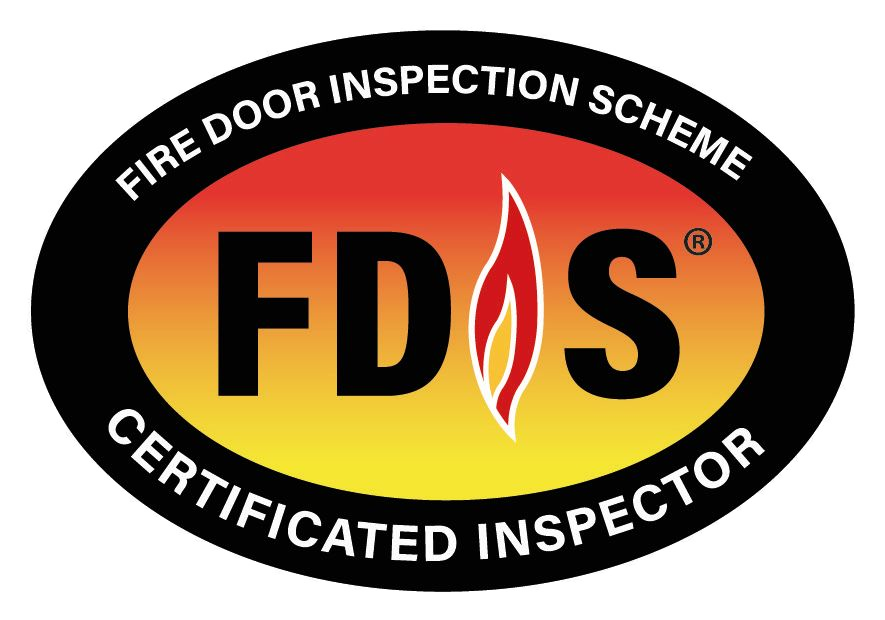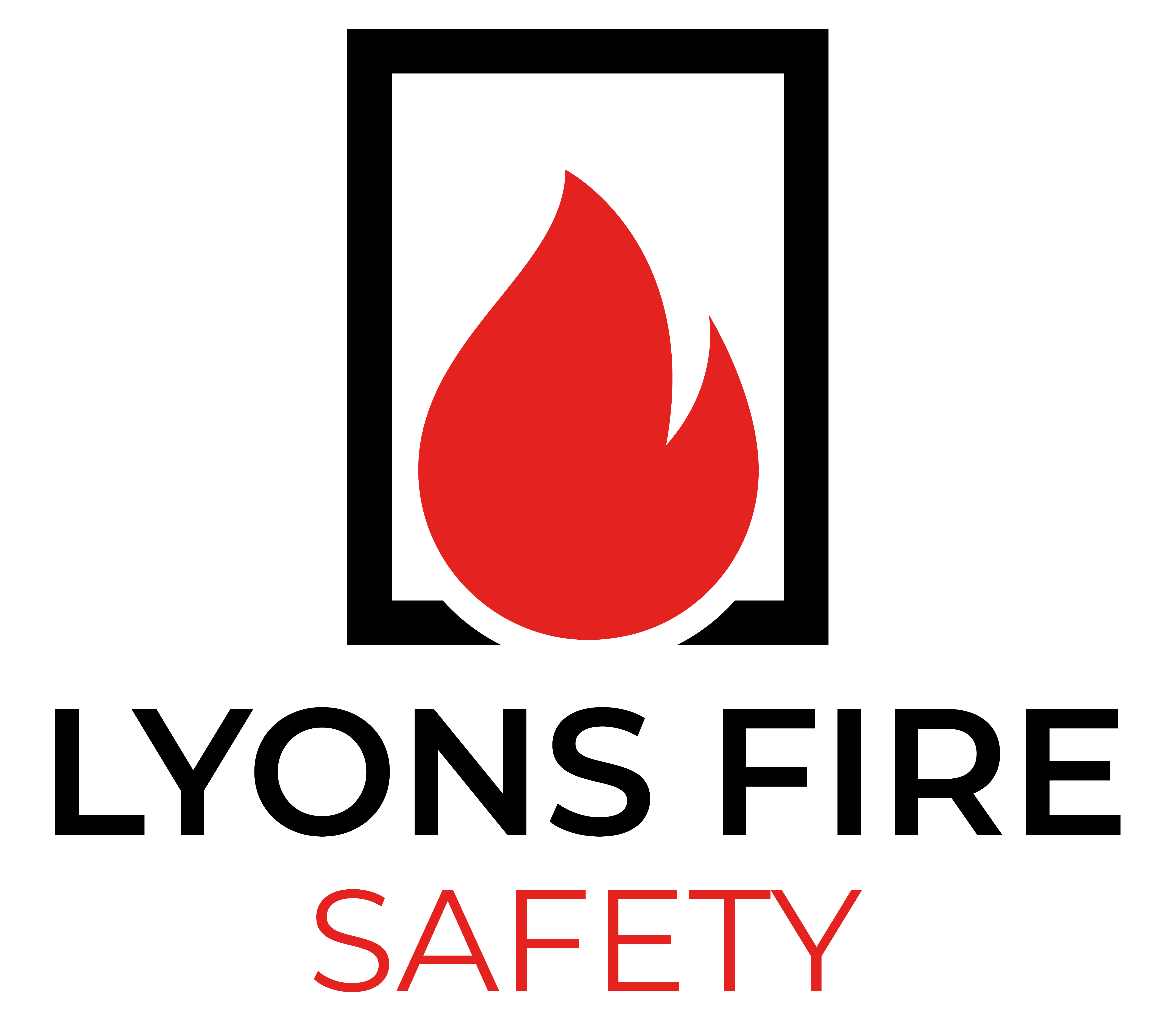Common Issues and Problems with Fire Doors: Identification, Prevention, and Solutions
Fire doors play a critical role in ensuring the safety of buildings and their occupants by preventing the spread of fire and smoke.
However, various issues can arise with fire doors, compromising their effectiveness and putting lives at risk. That’s where we come in in at Lyons Fire Safety (LFS).
In this comprehensive guide, we will explore common problems encountered with fire doors, explain how to identify them, and provide solutions through proper inspections, maintenance, and remedial works.
Excessive Gaps and Improperly Sealed Doors
One of the most common issues with fire doors is the presence of excessive gaps between door leaves or around the door frame – as depicted.
Here are the specific issues with the fire door in the image:
- Excessive Gap: The gap between the door leaves appears to be too large. According to BS 8214:2016 (Code of Practice for fire door assemblies), the maximum gap between the door leaves should generally not exceed 3mm. Gaps larger than this can allow smoke and flames to pass through, compromising the integrity of the fire door.
- Light Visible Through the Gap: The fact that light is visible through the gap indicates that it is not sealed properly. A properly installed fire door should not allow light (or smoke) to pass through the gaps.
- Potential Compromise of Fire Door’s Integrity: The gap may also indicate that the door is not closing properly, which could prevent it from performing its function in the event of a fire.
To comply with fire safety standards, the gap should be reduced to an acceptable size. Additionally, we would ensure a thorough further inspection. Checking whether it closes properly and seals all gaps when shut.
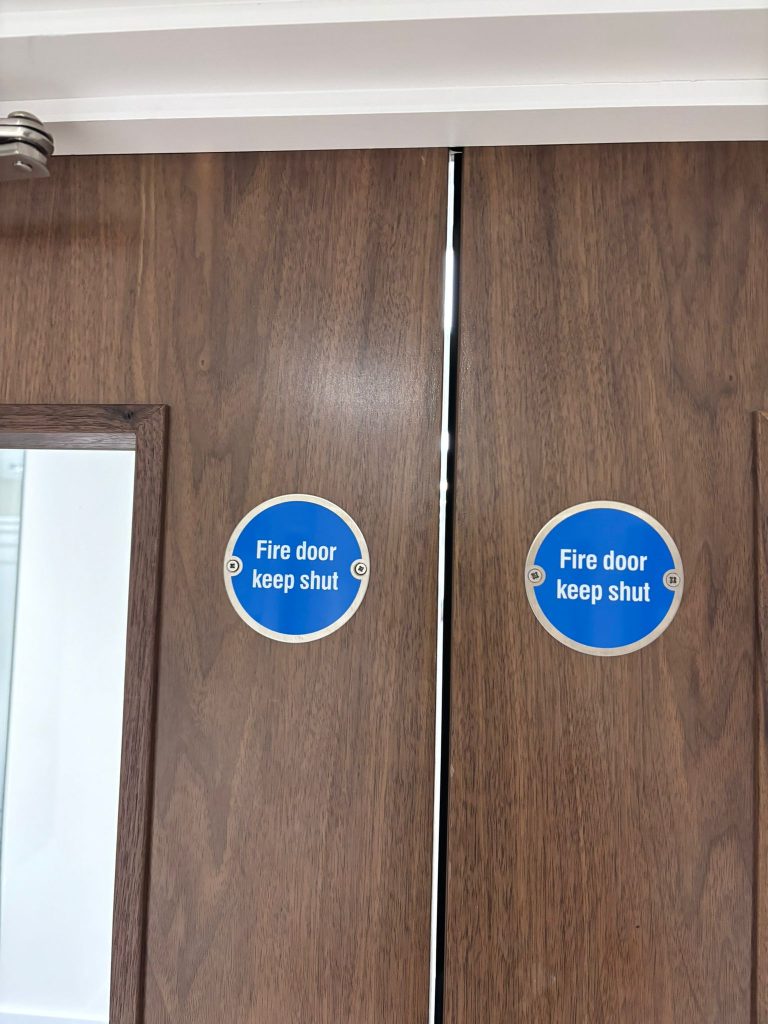
In this case, Fire seals or intumescent strips may need to be installed or adjusted to achieve the necessary fire resistance.
Incorrect or Damaged Ironmongery
Ironmongery, which includes hinges, closers, locks, and other hardware components, plays a crucial role in the proper functioning of fire doors. The correct selection, installation, and maintenance of these components are essential for ensuring the fire door operates as intended.
Common issues with ironmongery include:
- Incorrect Specification: Using the wrong type of hinges, closers, or locks can compromise the fire door’s performance and compliance with regulations.
- Damage or Wear: Over time, ironmongery components can become damaged or worn, affecting the door’s ability to close and seal properly.
- Improper Installation: Incorrectly installed ironmongery can lead to misalignment, binding, or other issues that prevent the door from operating correctly.
To address these problems, it is crucial to consult with fire door specialists, like us at LFS, who can identify the appropriate ironmongery. This can change for each situation. Regular inspections can catch issues early, allowing for timely repairs or replacements.
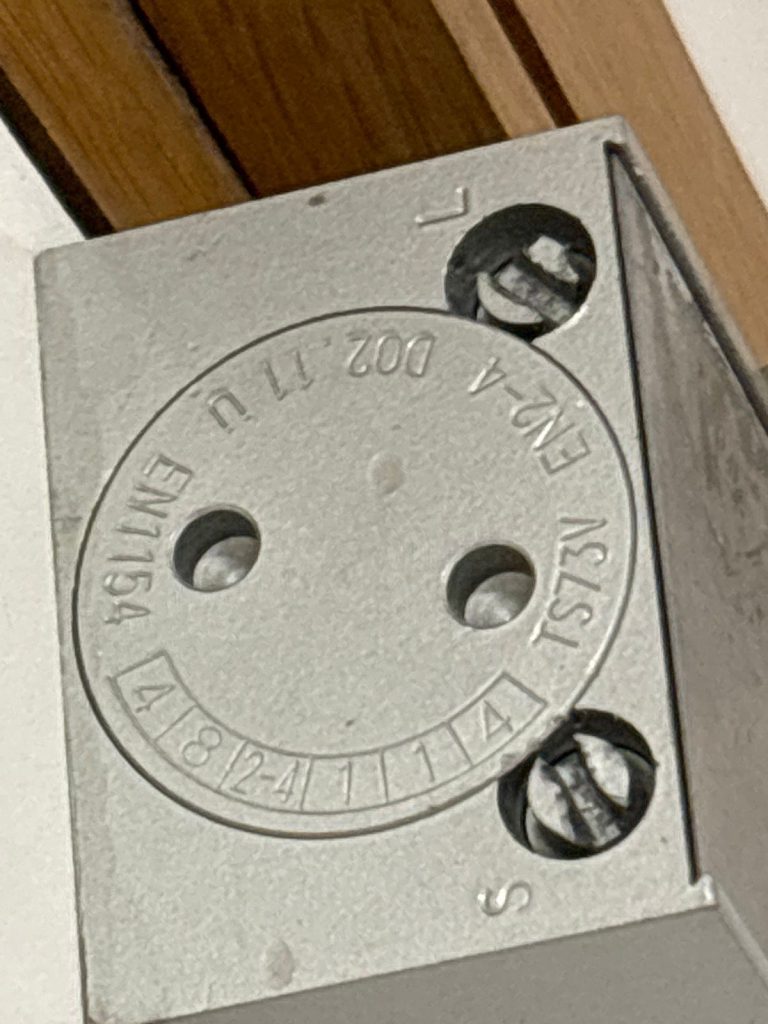
This image displays the correct identification of ironmongery within the correct situation.
Lack of Door Identity Notifications
Fire doors are required to have clear and visible identification markings to ensure they are easily recognisable in an emergency.
These markings, known as door identity notifications, typically include the fire resistance rating, the manufacturer’s name, and the product certification number.
If these markings are missing, obscured, or incorrectly applied, it can create confusion and hinder the effective management of fire safety within a building.
Additionally, take a look at our recent blog post on fire door ratings; learn more about how the correct rated fire door is essential to robust, fire safety.
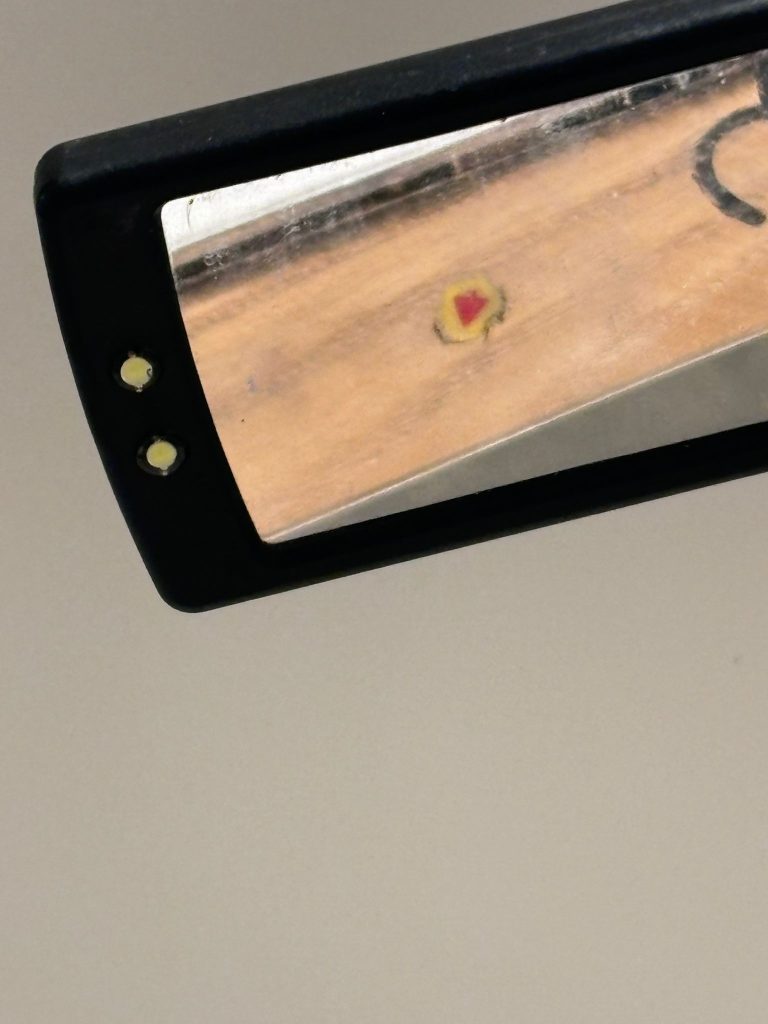
Common Fails and Problems
In addition to the issues mentioned above, there are several other common fails and problems that can arise with fire doors, including:
Damaged or Poorly Maintained Doors
Fire doors can become damaged over time due to wear and tear, vandalism, or improper maintenance. This can compromise their ability to perform as intended in a fire.
Obstructions
Objects placed in front of fire doors, such as furniture or equipment, can prevent them from closing properly and potentially block escape routes.
Propped Open Doors
Fire doors that are propped open defeat their purpose and pose a significant risk in the event of a fire.
Unauthorised Modifications
Any unauthorised modifications to fire doors, such as drilling holes or installing non-compliant hardware, can compromise their fire resistance and performance.
We can help identify and address these common issues, ensuring fire doors. Ensuring that you, as our client, remain compliant with regulations.
Learn more here – passive fire protection systems – about the services we provide regarding Passive fire protection, beyond fire door safety.
Remedial Fire Door Safety Work at Lyons Fire Safety
During a routine inspection, we identified significant issues with fire doors that were in need of some remedial. Our inspection revealed improper installation and a mix of intumescent seals used incorrectly. Naturally, this compromised the fire door’s ability to provide the necessary protection.
Upon examining the fire door, several critical issues were noted:
- Incorrect Use of Intumescent Seals: The inspection revealed a mix of intumescent seals that were not suitable for the door assembly. Intumescent seals are crucial for expanding and sealing gaps during a fire, preventing the spread of smoke and flames. The incorrect application can result in insufficient sealing.
- Substandard Workmanship: The installation of the seals appeared haphazard, with visible gaps and misalignments. The seals were not flush with the door frame, reducing their effectiveness.
- Non-Compliant Components: Some of the components used did not meet the required fire safety standards, further compromising the door’s integrity.
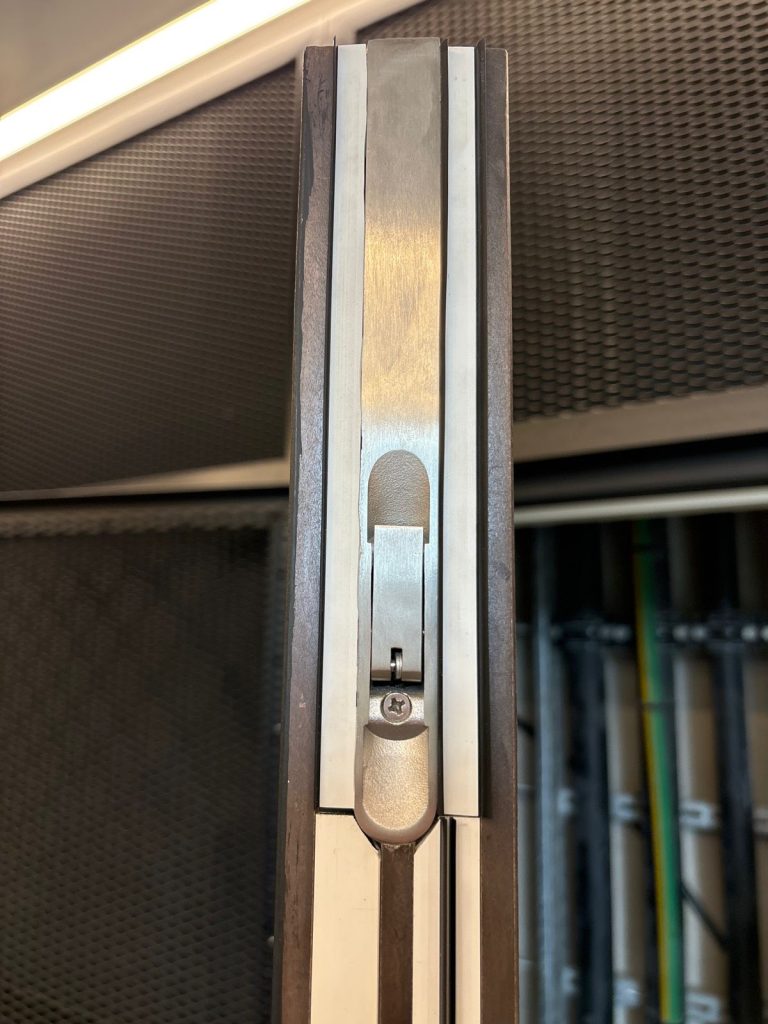
How we Resolved this Fire Door Issue
To address these issues, we conducted a thorough remedial process to ensure the fire door met all relevant safety standards:
Removal of Incorrect Seals
The first step involved carefully removing all the incorrectly applied intumescent seals. This was done to ensure a clean surface for the installation of new, compliant seals.
Selection of Appropriate Seals
LFS selected the correct type and size of intumescent seals, in accordance with BS 8214:2016 and the manufacturer’s specifications. These seals were chosen to match the door assembly and provide the necessary expansion and sealing properties in the event of a fire.
Precise Installation
The new intumescent seals were installed with precision, ensuring they were flush with the door frame and had no visible gaps. This meticulous installation was critical to restore the fire door’s integrity.
Quality Assurance
After installation, a comprehensive quality assurance check was conducted to verify that the seals were correctly applied and met all fire safety standards. This included testing the door’s closure mechanism to ensure it functioned properly and that the seals activated as intended.
This case underscores the importance of using the correct materials and following proper installation procedures for fire safety components. Our commitment is simple – maintaining the highest standards of fire safety through diligent inspection and precise remedial work. Don’t hesitate to get in touch for fire door inspections, installations, remedial work and maintenance
Fire Door Problems & Issues - FAQs
How often should fire doors be inspected?
Fire doors should be inspected regularly, typically every six months or as recommended by the manufacturer or local regulations. Regular inspections help identify any issues or potential problems before they become a significant safety hazard.
Can fire doors be repaired, or do they need to be replaced?
In some cases, fire doors can be repaired if the damage is minor and does not compromise their fire resistance rating. However, if the damage is significant or affects the door’s ability to perform its intended function, replacement may be necessary.
What is the importance of using certified ironmongery for fire doors?
Certified ironmongery is essential. Hardware components must have been tested and approved for use in fire-rated applications. Using non-certified ironmongery can compromise the fire door’s performance and put occupants at risk.
Can fire doors be painted or decorated?
Fire doors can be painted or decorated, but it is crucial to use compatible products. Moreover, this products cannot affect the door’s fire resistance rating.
What should be done if a fire door is propped open?
Propping open fire doors is a serious safety violation and should be addressed immediately. Building occupants should be educated on the importance of keeping fire doors closed at all times. Additionally, any instances of propped open doors should be reported and rectified promptly.
Choose Lyons Fire Safety for Fire Door Solutions UK
At Lyons Fire Safety, we are committed to providing exceptional fire door solutions and ensuring the highest level of safety and compliance for our clients. Our team of qualified professionals uses certified products and follows industry best practices to ensure the desired fire resistance rating is achieved.
Don’t compromise on fire safety. Contact us today to schedule an assessment, inspection, or maintenance service for your fire doors. Our experts will identify any issues, provide recommendations, and implement effective solutions to ensure your fire doors are functioning optimally and compliant with regulations.
Phone: 0121 517 0562
Email: david@lyonsfiresafety.co.uk
Lyons Fire Safety: Your Trusted Partner for Fire Door Inspections, Maintenance, Upgrades, and Compliance Solutions in the UK.
